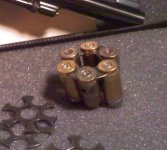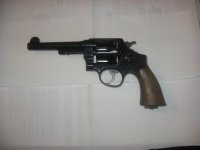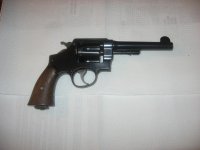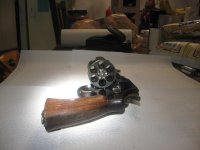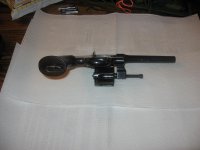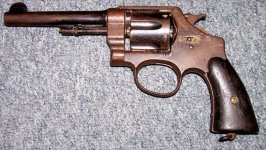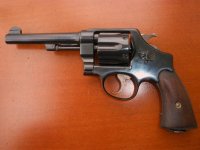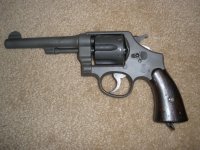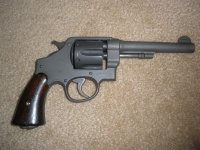Well, the frame is 20 years newer than the WW I built 1917s and if there were any improvements, your revolver has them. You definitely have a better sight picture with the square rear sight notch.
You are using an out of date browser. It may not display this or other websites correctly.
You should upgrade or use an alternative browser.
You should upgrade or use an alternative browser.
Let's see your U.S. Model 1917 S&Ws!
- Thread starter PALADIN85020
- Start date
gordonrick
Member
Another Brazilian
Purchased in the late 80's via Shotgun News for $150, SN 184xxx. Aside from showing a lot of "history", this gun still shoots great and is the only gun my wife will shoot.

Purchased in the late 80's via Shotgun News for $150, SN 184xxx. Aside from showing a lot of "history", this gun still shoots great and is the only gun my wife will shoot.

Wheelgunner840
Member
This model of 1917 was recently a gift to me from a very dear friend. I have a thread here in this sub-forum with the story if anyone cares to read it.
http://smith-wessonforum.com/s-w-ha...0506-model-1917-great-friend-pics-posted.html
It belonged to my friend, and I have shot it several times in the past. I plan on continuing to shoot it, as that is what it was meant to do!
This gun is lettered as having been shipped in 1918. It is very close to 96%.


Needless to say, I will be keeping this for a very long time.
PS; Ignore the bad photobucket editing mistake I made on the front site on the top picture. It looks the same as the other side in the lower picture!
WG840
http://smith-wessonforum.com/s-w-ha...0506-model-1917-great-friend-pics-posted.html
It belonged to my friend, and I have shot it several times in the past. I plan on continuing to shoot it, as that is what it was meant to do!
This gun is lettered as having been shipped in 1918. It is very close to 96%.


Needless to say, I will be keeping this for a very long time.
PS; Ignore the bad photobucket editing mistake I made on the front site on the top picture. It looks the same as the other side in the lower picture!
WG840
Last edited:
Deacon KC
Member
I just swapped for one, on it's way in from Alabama! Hurry up Fedex!
JJ_BPK
US Veteran
This model of 1917 was recently a gift to me from a very dear friend.
WG840
Very nice,,
Courious??
Are these home=made snap-caps??
Attachments
Wheelgunner840
Member
JJ_BPK;Very nice,,
Courious??
Are these home=made snap-caps??
Thank you.
Yes , those are dummy rounds that can be used for dry firing, and or for reloading practice. Most of the cases have holes drilled into them, and all have spent primers.
WG840
Hurryin' Hoosier
US Veteran
The first handgun I ever owned was a 1917 of the Colt persuasion. I gave $25 for it in 1967. Great old gun which I, dummy that I was, traded off for something or other. I've kicked myself ever since!
Deacon-KC
Member
An easy and cheap way to make dummy rounds is to use the small erasers you get at an office supply for mechanical pencil refills. Just glue them into the primer pocket and sand flat to depth.
Deacon-KC
Member


The finish s rough but will clean up, excellent rifling, SN 633xx
NORWICH CADET
Member
- Joined
- May 13, 2005
- Messages
- 89
- Reaction score
- 63
Ive been away for a while lurking over in the Colt web sight. Here's picture of my very early SN 8398 1917.


Deacon KC
Member
Got the old beastie cleaned up,




shep854
Member
This is an incredible thread; I just finished going through all 20 pages of history! It's been very educational as well; I've gotten some ideas for my civ 1917.
Looking at the shortened guns, I can see where they would be ideal for naval aircrews in WWII; if they went into the drink, they would have .45 performance in a compact, rust-resistant package (I've read where naval aircrew preferred revolvers, since autos, in their opinion rusted to uselessness much faster than a revolver).
Looking at the shortened guns, I can see where they would be ideal for naval aircrews in WWII; if they went into the drink, they would have .45 performance in a compact, rust-resistant package (I've read where naval aircrew preferred revolvers, since autos, in their opinion rusted to uselessness much faster than a revolver).
Melsurp,
Nice recovery of that old wasp nest. The hammer you used is a scarce one that only appeared before early 1918. You were lucky to find it.
Bob
Nice recovery of that old wasp nest. The hammer you used is a scarce one that only appeared before early 1918. You were lucky to find it.
Bob
shep854
Member
Yep, that is a really nice save!Here are before and after pics of my 1917. It had a wasp nest in one cylinder! Found internals, which were missing, and had it reblued. It is tight and is a great shooter!
Where can I find a listing of serial numbers/US Army numbers on model 1917's? Thank you; jpcleveland
This is an incredible thread; I just finished going through all 20 pages of history! It's been very educational as well; I've gotten some ideas for my civ 1917.
Looking at the shortened guns, I can see where they would be ideal for naval aircrews in WWII; if they went into the drink, they would have .45 performance in a compact, rust-resistant package (I've read where naval aircrew preferred revolvers, since autos, in their opinion rusted to uselessness much faster than a revolver).
Since military regulations required that the 1911 autos be carried with a loaded magazine and an empty chamber, those guns generally required two hands to get into action. This was not true of the revolvers. One hand could be used to work the aircraft's mechanisms, and the other hand could have an instantly-ready handgun in it.
John
shep854
Member
Good point.Since military regulations required that the 1911 autos be carried with a loaded magazine and an empty chamber, those guns generally required two hands to get into action. This was not true of the revolvers. One hand could be used to work the aircraft's mechanisms, and the other hand could have an instantly-ready handgun in it.
John
I once read an account of a crew that had to ditch; it was stated that .45s rusted to uselessness much more quickly than revolvers. Not stated was if the respective guns had been properly maintained. To most aircrew, their pistols was just a metal lump to be hauled around--until they needed it...
MikeNC
Member
- Joined
- Mar 6, 2012
- Messages
- 19
- Reaction score
- 8
Hi Everyone....I'm a newbie here on the site, just signed up a few minutes ago. I was going to introduce myself but got side tracked by all the cool and informative posts and display of nice guns. This is like being in a candy shop! What great looking war horses are shown here. Here are some photos of the one I acquired in 1968. A couple photos show what appears to be a whitish mark on the barrel, but that is just some light reflection. Hope ya like it....Mike
















shep854
Member
VERY nice, Mike! Is that the original finish? If so, kudos for taking very good care of it!
Also, welcome to the forum! We hope you have many more treasures (and experience) to share.
Also, welcome to the forum! We hope you have many more treasures (and experience) to share.
Mike,
Welcome to the forum! Glad to have you here. Those are great photos you've posted, and the gun really sparkles. The finish looks brand new, prompting me to also ask if it's a re-finish. If not, it's a genuine gem, and if it is, it's been well done!
John
Welcome to the forum! Glad to have you here. Those are great photos you've posted, and the gun really sparkles. The finish looks brand new, prompting me to also ask if it's a re-finish. If not, it's a genuine gem, and if it is, it's been well done!
John
MikeNC
Member
- Joined
- Mar 6, 2012
- Messages
- 19
- Reaction score
- 8
Thanks Palladin and Shep....
As far as it being the original finish is a long story. I'll keep it short. Up until today I always figured it was an original finish. Now, I'm not sure. I got this gun back in 1968 when I was a high school senior in Ohio. A guy owed me some money on a bet concerning a Cleveland Browns vs Pittsburgh Stealers football game. He offered me this pistol in lieu of the cash. The gun had belonged in his fathers collection which was passed on to him. He told me that this particular gun was very special to his father. He didn't know the whole story and I didn't listen too closely anyway's. It looked like a cool gun that Bonnie and Clyde would have used and I accepted it as trade. It has been in a gun safe or T-shirt drawer ever since protecting the house...LOL I also kept it wrapped in a heavy sock for extra protection.
I have read that S&W had a lustrous blue on their original guns while Colt had a subdued finish and I figured I had an original finished gun, but now I'm not so sure. I called a Smith and Wesson collecting expert today and sent him these same photos. He told me to take the hand grips off and look for some marks on the frame. He figured the gun had been re-finished but expected it to have been a professional job done by the factory. I looked for the specific marks he told me about, but they were not present. He told me that I have an exceptional gun here, but it has been refinished in his opinion. So if it was re finished it was done by someone else. I know that the gun has looked this exact same way since 1968. So anyhow, that's what I know. Any other opinion would certainly be welcome. thanks...Mike
As far as it being the original finish is a long story. I'll keep it short. Up until today I always figured it was an original finish. Now, I'm not sure. I got this gun back in 1968 when I was a high school senior in Ohio. A guy owed me some money on a bet concerning a Cleveland Browns vs Pittsburgh Stealers football game. He offered me this pistol in lieu of the cash. The gun had belonged in his fathers collection which was passed on to him. He told me that this particular gun was very special to his father. He didn't know the whole story and I didn't listen too closely anyway's. It looked like a cool gun that Bonnie and Clyde would have used and I accepted it as trade. It has been in a gun safe or T-shirt drawer ever since protecting the house...LOL I also kept it wrapped in a heavy sock for extra protection.
I have read that S&W had a lustrous blue on their original guns while Colt had a subdued finish and I figured I had an original finished gun, but now I'm not so sure. I called a Smith and Wesson collecting expert today and sent him these same photos. He told me to take the hand grips off and look for some marks on the frame. He figured the gun had been re-finished but expected it to have been a professional job done by the factory. I looked for the specific marks he told me about, but they were not present. He told me that I have an exceptional gun here, but it has been refinished in his opinion. So if it was re finished it was done by someone else. I know that the gun has looked this exact same way since 1968. So anyhow, that's what I know. Any other opinion would certainly be welcome. thanks...Mike
1917 converted to target years ago before the war for a former owner. Redfield front site blade milled in, pre war S&W rear site milled in, Micro site double cockeyed hammer. S&W stocks are early 1950s smooth earliest 'cokes'.








Last edited:
As far as it being the original finish is a long story. I'll keep it short. Up until today I always figured it was an original finish. Now, I'm not sure. I got this gun back in 1968 when I was a high school senior in Ohio. A guy owed me some money on a bet concerning a Cleveland Browns vs Pittsburgh Stealers football game. He offered me this pistol in lieu of the cash. The gun had belonged in his fathers collection which was passed on to him. He told me that this particular gun was very special to his father. He didn't know the whole story and I didn't listen too closely anyway's. It looked like a cool gun that Bonnie and Clyde would have used and I accepted it as trade. It has been in a gun safe or T-shirt drawer ever since protecting the house...LOL I also kept it wrapped in a heavy sock for extra protection.
I have read that S&W had a lustrous blue on their original guns while Colt had a subdued finish and I figured I had an original finished gun, but now I'm not so sure. I called a Smith and Wesson collecting expert today and sent him these same photos. He told me to take the hand grips off and look for some marks on the frame. He figured the gun had been re-finished but expected it to have been a professional job done by the factory. I looked for the specific marks he told me about, but they were not present. He told me that I have an exceptional gun here, but it has been refinished in his opinion. So if it was re finished it was done by someone else. I know that the gun has looked this exact same way since 1968. So anyhow, that's what I know. Any other opinion would certainly be welcome. thanks...Mike
Mike, take a look at the cylinder stop which projects from the frame at the lower left of the frame window. As I view your pictures, it appears that what should be sharp corners on an original factory blue are rounded over there. Also, I think I detect minor dings on the barrel which are blued over - a normal ding would remove the bluing in the minor gouging.
These are signs of a re-blue. However, I think yours was generally well done; it's a very pretty piece, and you should be proud of it.
John
MikeNC
Member
- Joined
- Mar 6, 2012
- Messages
- 19
- Reaction score
- 8
These are signs of a re-blue. However, I think yours was generally well done; it's a very pretty piece, and you should be proud of it.
John
Thanks John. The gun has gotten a lot of attention over the years when I show it to someone. I'll still keep it in my T-shirt drawer away from holsters and such until I decide what to do with it, as I just hate to put a mark on it....Mike
Mike,
Welcome to the Forum. That is a very nice old M1917. However, like John, I also believe that it has been very nicely refinished.
To help you a little in establishing the production date of your revolver, there are three characteristics of the early M1917's that we rely on. The earliest ones had fine concentric grooves on the sides of the hammer. That feature was dropped approximately Feb. 1918 at serial number approx. 25,000. The early guns also have the inspector's initials GHS in a circle on the left side in front of the hammer. This was replaced with the Ordinance Bomb mark after April, 1918, The early grips had the concave top and that was replaced around March, 1918 and serial number 30,000 with the non recessed tops in the later guns.
Since your gun does not have the concentric grooves in the hammer but still does have the GHS initials and the concave grips, we can conclude that it was produced somewhere in the March-April 1918 time frame. However, as always with the S&W factory, things aren't necessarily as they seem. The grooved hammer was replaced somewhere around 25,000 and your's is 18,788 so we could conclude that either the hammer was replaced later in the guns life (perhaps when it was refinished) or the gun was assembled at the factory later from an early frame and grips. More likely, your gun was simply a little out of the normal production sequence and/or the estimates of the changes aren't exact.
Bob
Welcome to the Forum. That is a very nice old M1917. However, like John, I also believe that it has been very nicely refinished.
To help you a little in establishing the production date of your revolver, there are three characteristics of the early M1917's that we rely on. The earliest ones had fine concentric grooves on the sides of the hammer. That feature was dropped approximately Feb. 1918 at serial number approx. 25,000. The early guns also have the inspector's initials GHS in a circle on the left side in front of the hammer. This was replaced with the Ordinance Bomb mark after April, 1918, The early grips had the concave top and that was replaced around March, 1918 and serial number 30,000 with the non recessed tops in the later guns.
Since your gun does not have the concentric grooves in the hammer but still does have the GHS initials and the concave grips, we can conclude that it was produced somewhere in the March-April 1918 time frame. However, as always with the S&W factory, things aren't necessarily as they seem. The grooved hammer was replaced somewhere around 25,000 and your's is 18,788 so we could conclude that either the hammer was replaced later in the guns life (perhaps when it was refinished) or the gun was assembled at the factory later from an early frame and grips. More likely, your gun was simply a little out of the normal production sequence and/or the estimates of the changes aren't exact.
Bob
shep854
Member
So now you know the truth; thrown together with whatever parts were laying around, THEN given a quickie reblueing later on--obviously a piece of junk, with no value.
I'll give you $100 for it, so you won't feel too bad...

I'll give you $100 for it, so you won't feel too bad...
Similar threads
- Replies
- 8
- Views
- 11K
- Replies
- 33
- Views
- 6K
- Replies
- 15
- Views
- 10K
- Replies
- 18
- Views
- 4K

